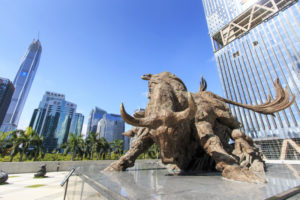(Bloomberg) — It’s easy to see why doubters of China’s world-beating equity rally are growing louder.
Manufacturing contracted last month for the first time in two years, industrial profits are falling at the fastest pace since at least 2011 and the government is clamping down on trading with borrowed money. After a 63 percent surge in six months, the CSI 300 Index posted its biggest drop in a year last week.
Yet for the Chinese stock strategist who helped deliver the best returns among Asian hedge funds with at least $1 billion of assets last year, the bears are short-sighted. Joseph Zeng, who helps run the Golden China Fund with Greenwoods Asset Management founder George Jiang, says the $5.1 trillion market is only in the first phase of a three-part rally.
While Zeng declined to put a target on how high the CSI 300 index of locally traded A shares will climb and says there will be corrections along the way, his forecast that the gauge may trade at a multiple of as much as 30 times earnings gives an idea of what may be in store. That estimate implies an additional 100 percent gain, even if corporate profits flat-line at current levels. Here’s how Zeng sees the rally playing out:
* Phase One: Valuations Return to Normal
Much of the gains in Chinese stocks can be explained by a return to historical valuation levels, according to Zeng. When the rally began accelerating six months ago, the CSI 300 traded at about 9.6 times reported earnings, versus the decade average of 19 times. The gauge now has a multiple of 15, and Zeng says a “fair” valuation would be a range of 20 to 30. When the market peaked in 2007, the price-to-earnings ratio was 49, according to data compiled by Bloomberg.
“Over the last three to six months, the biggest driver of the A-share market’s rally was the normalization of valuation,” said Zeng. “Why should it be trading at such a low level? The market’s sentiment is back to normal.”
* Phase Two: Earnings Recovery
Chinese profits will probably start rebounding in the second or third quarter as the central bank’s interest-rate cut in November filters through the economy, Zeng said. He predicts further reductions in borrowing costs as falling commodity prices keep inflation contained. Profits in the CSI 300 index are poised to climb about 24 percent during the next 12 months, according to analyst estimates compiled by Bloomberg. The gauge rose 2.5 percent on Tuesday, halting a five-day decline.
“The Phase Two rally can be longer and stronger,” said Zeng, who favors consumer-discretionary companies such as appliance makers and jewelry retailers. “This isn’t about liquidity or margin debt. We are talking about fundamentals. If you see a recovery in earnings because of monetary easing — which just started — upward revision of earnings should last two to three years. That can be a big support for the rally.”
* Phase Three: Global Inflows
The final stage of the rally will come when global investors start pouring money into Chinese shares, Zeng said. So far, they’ve yet to pile in. Overseas exchange-traded funds tracking mainland equities recorded outflows for four straight months through January, while foreigners have used up just 30 percent of their quota of Shanghai stock purchases through the city’s exchange link with Hong Kong, according to data compiled by Bloomberg. The potential inclusion of mainland shares in MSCI Inc.’s global indexes may persuade global funds to increase holdings, Zeng said.
“Most international investors didn’t benefit from the Phase One rally,” Zeng said. “Local smart money benefited. When you hear mums and pops in Oklahoma talking about Chinese stocks, that’s the time global liquidity is coming in.”


